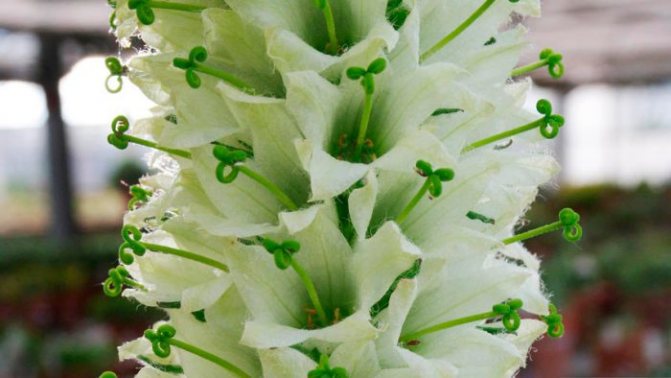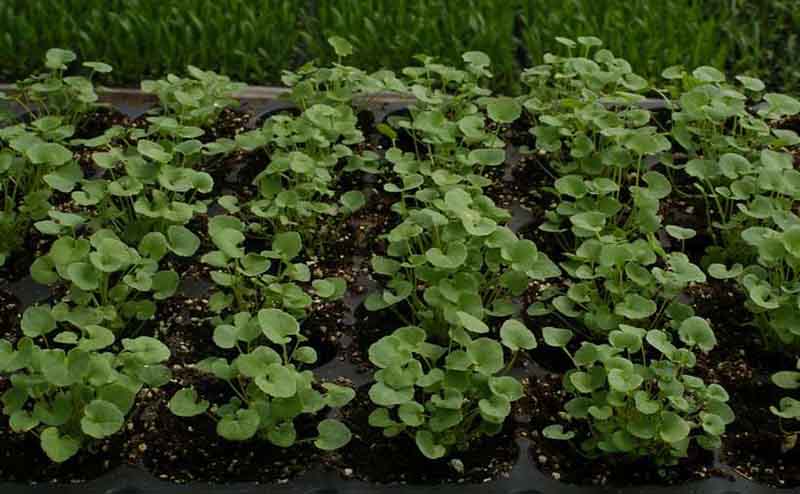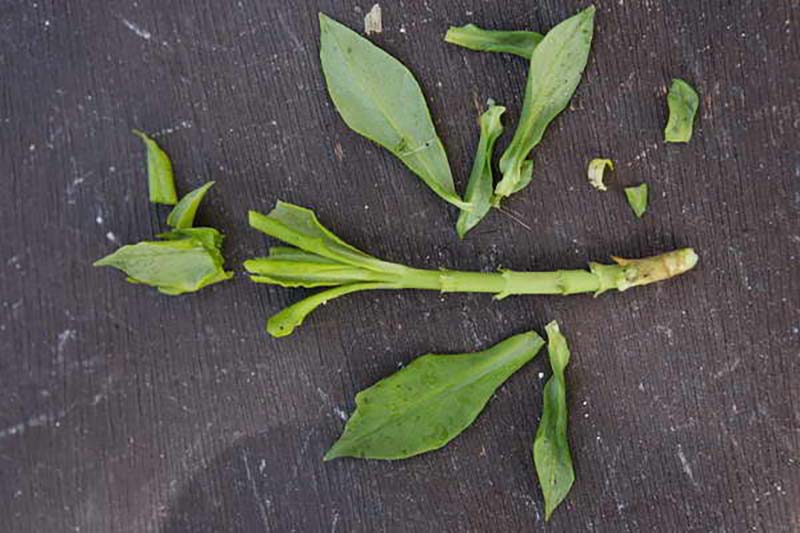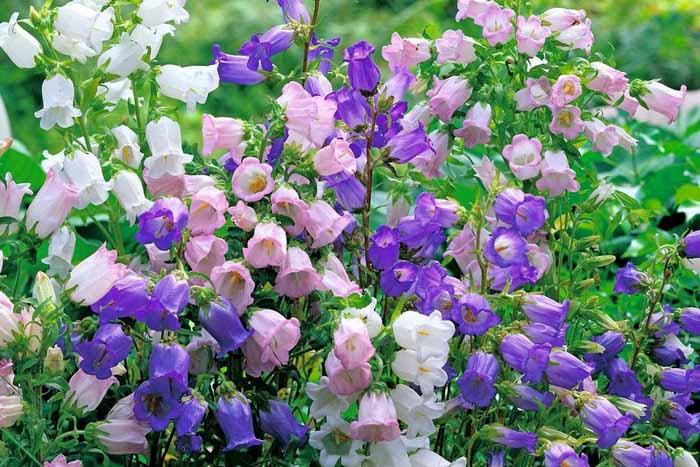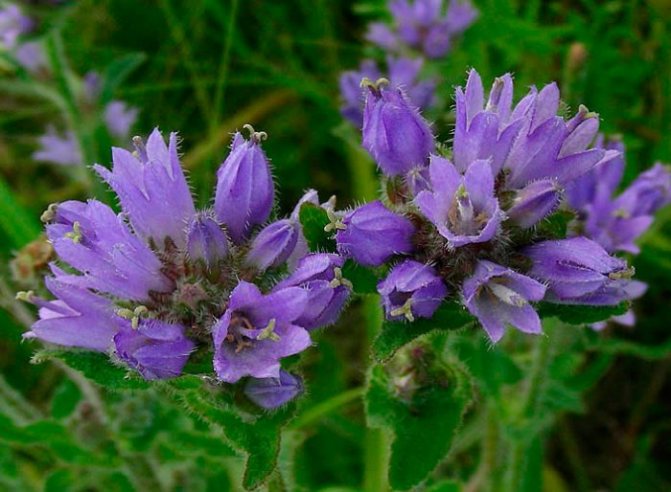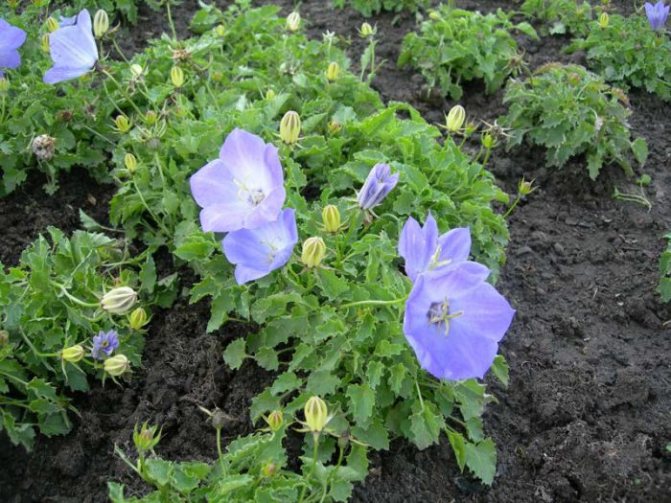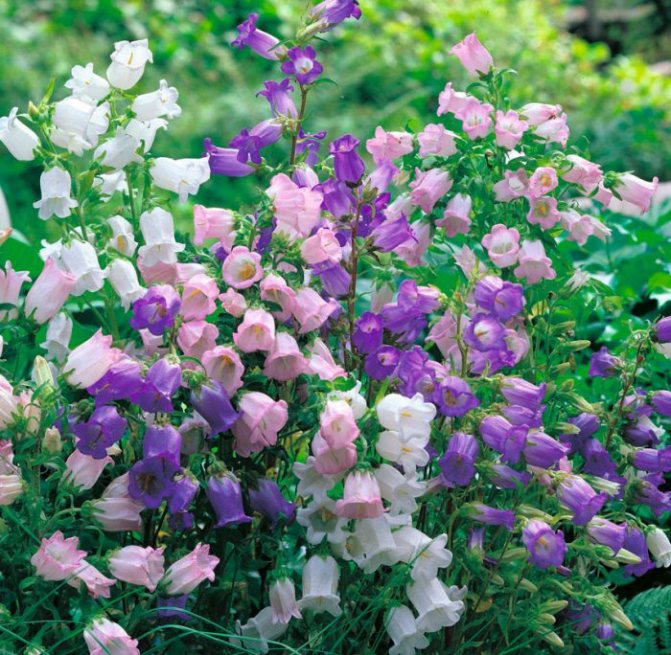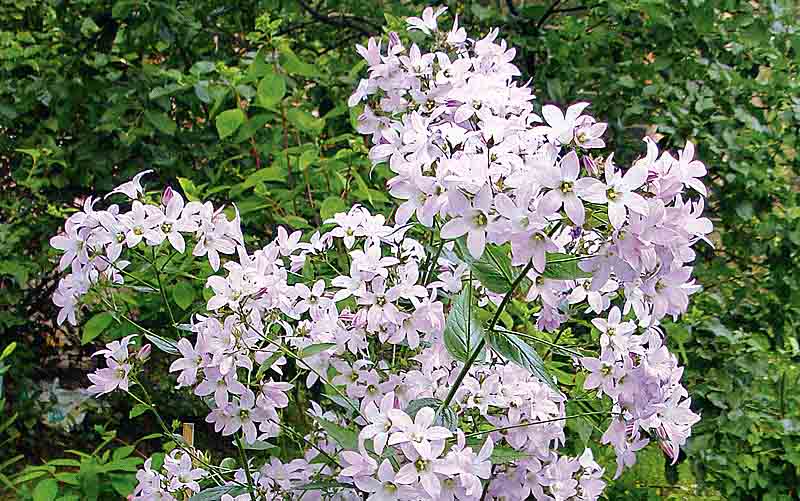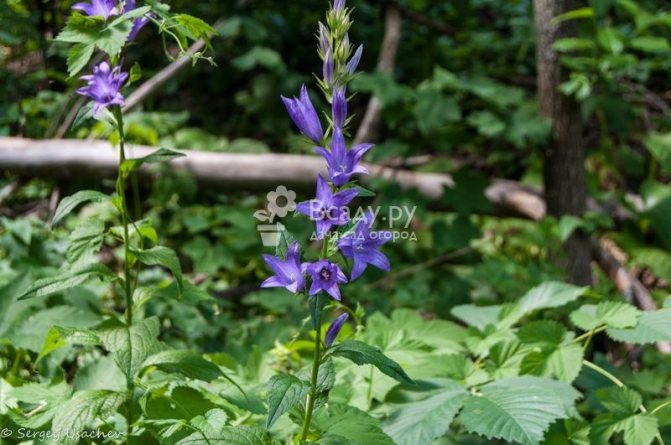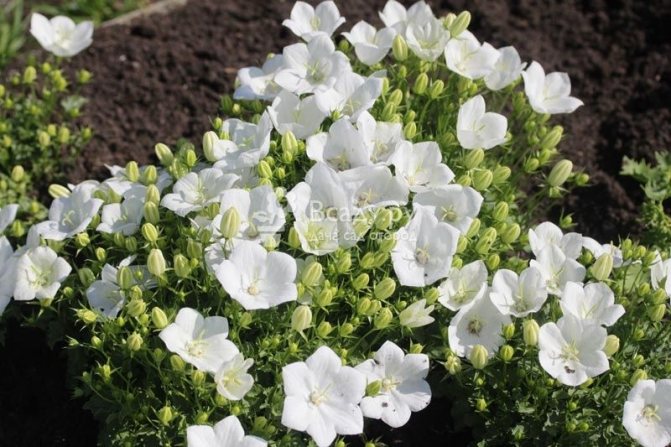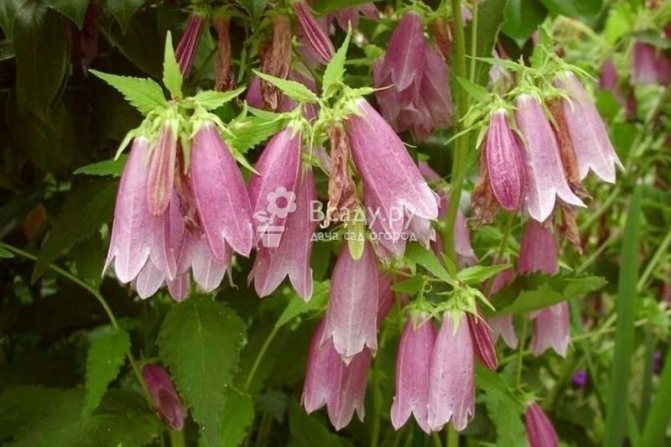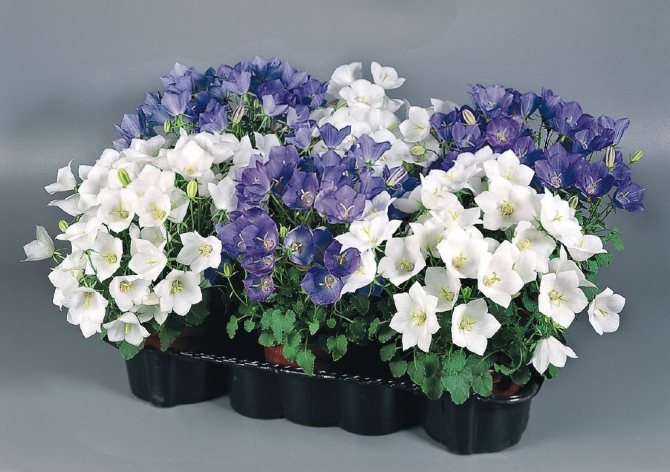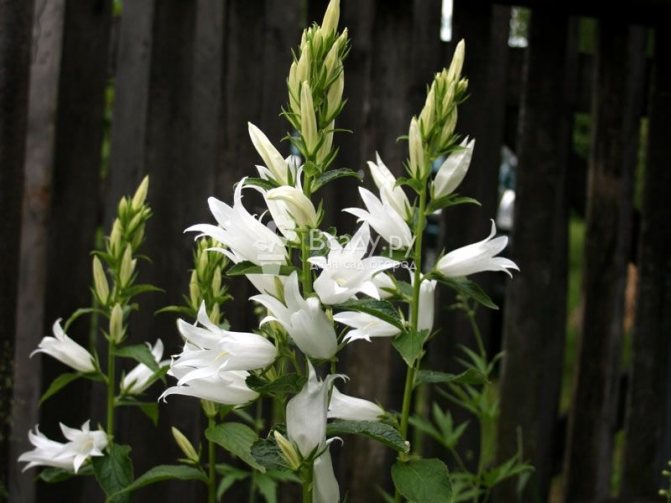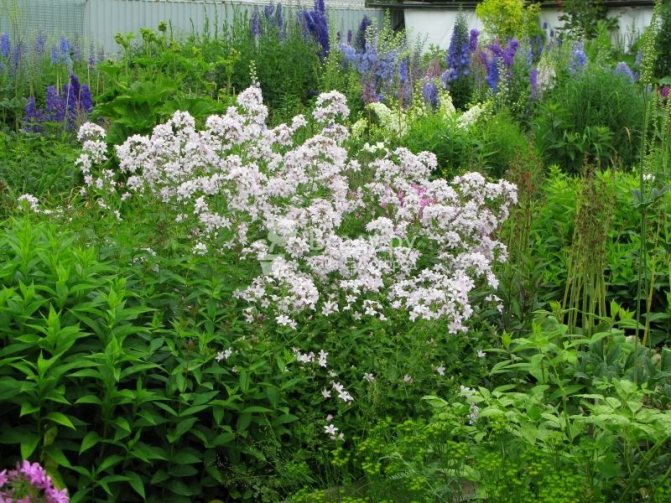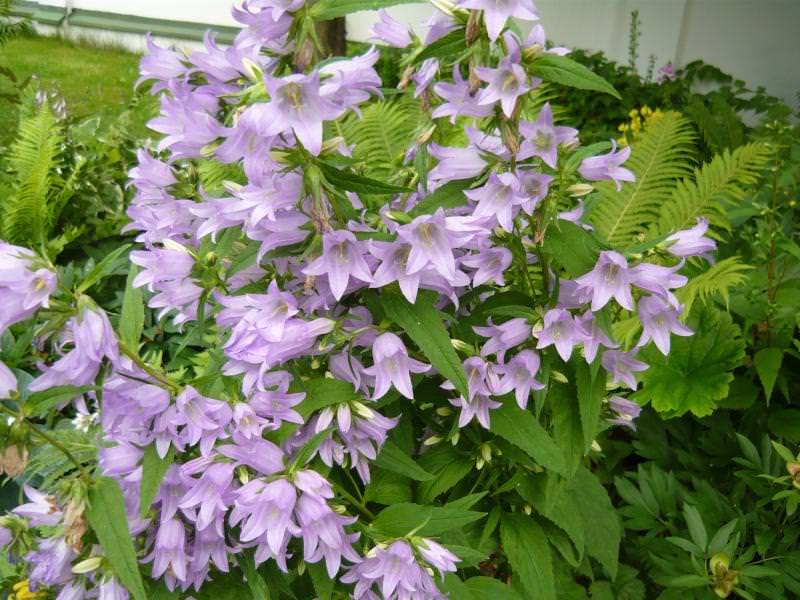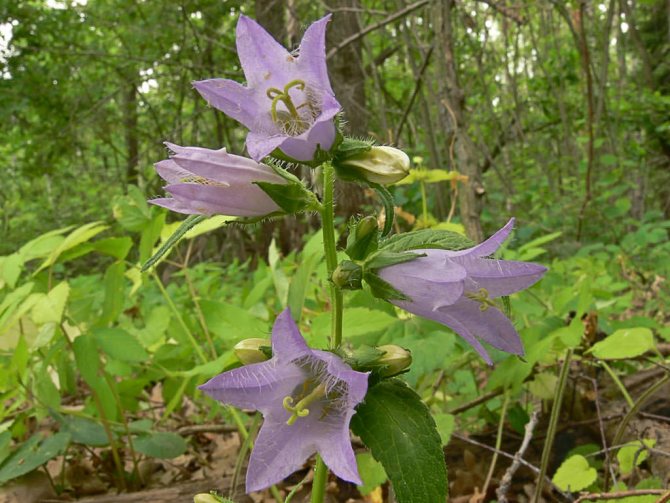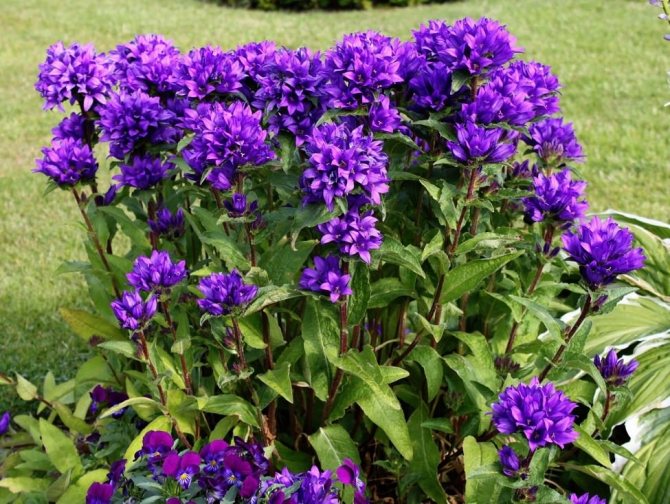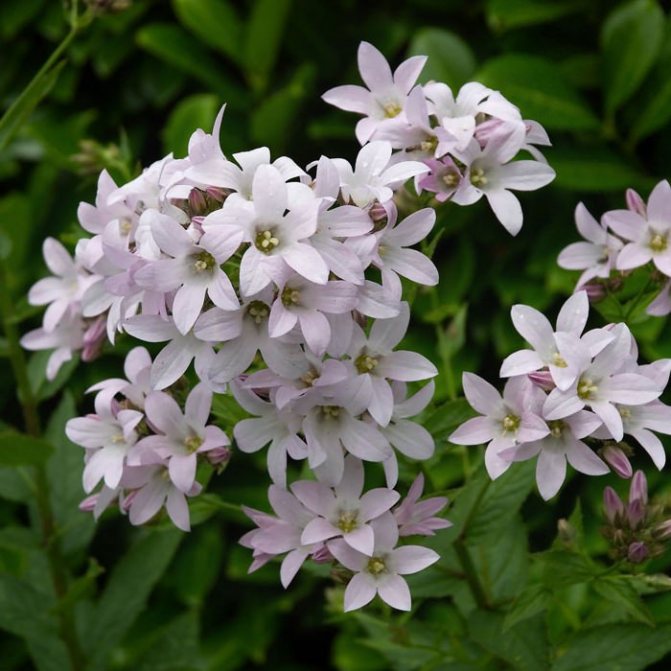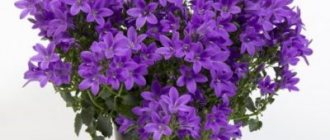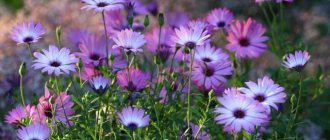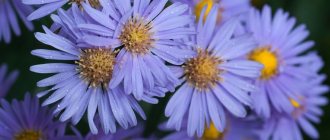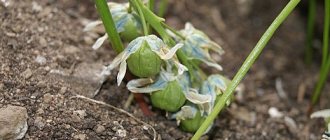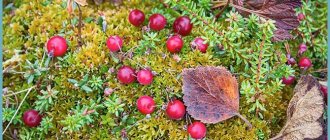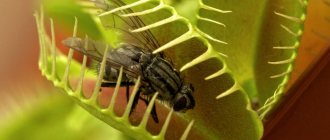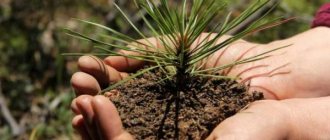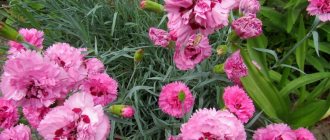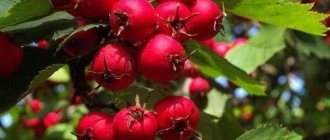Perennial herb Campanula garden is a plant that will diversify the composition of flowers in your garden.
The crop is impressive with a variety of varieties (up to 300 varieties) that can be used for outdoor cultivation. Taking into account the peculiarities of planting and care, you can choose the option that is best for your area.
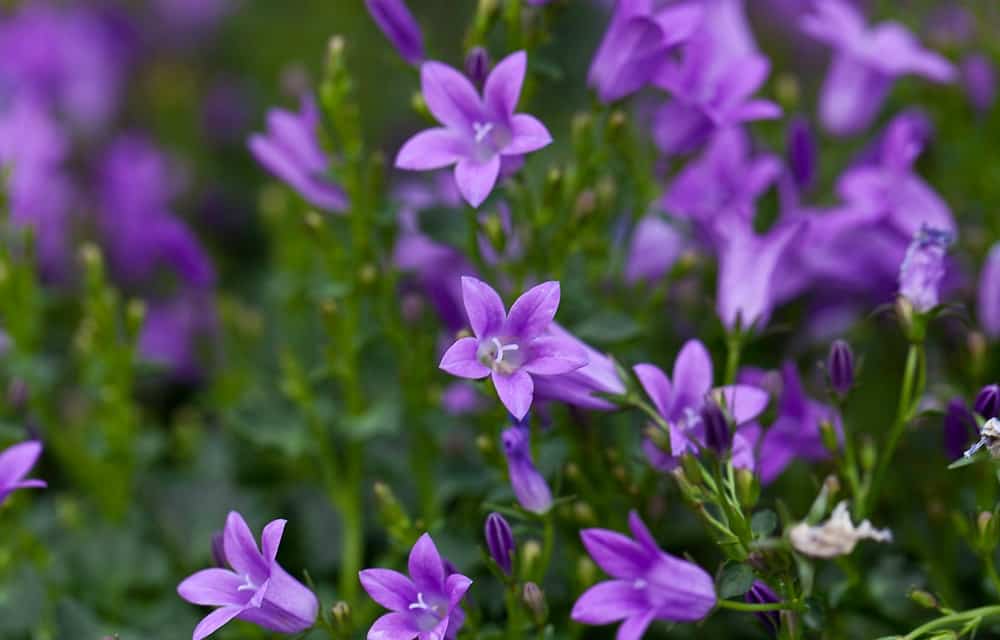
Description of culture
The flower, the photo of which is impressive in its brightness, belongs to the bellflower family. His homeland is countries with a temperate climate. The habitat can be rocks and wastelands, meadows, steppe areas, woodlands.
The height of the plant varies between 40-100 cm. Its characteristic feature is different stems, they can be:
- thin creeping;
- thick, erect.
The shoots of the plant are strewn with carved leaves in the shape of a heart in a rich green hue. They grow up to 7 cm in length and are located on long cuttings.
The buds have an interesting configuration, they resemble a pyramid of different shades. Here you can see white, pink, lilac and blue flowers with a diameter of 2-4 cm. They begin to delight the gaze of the gardener in summer, sometimes even in September.
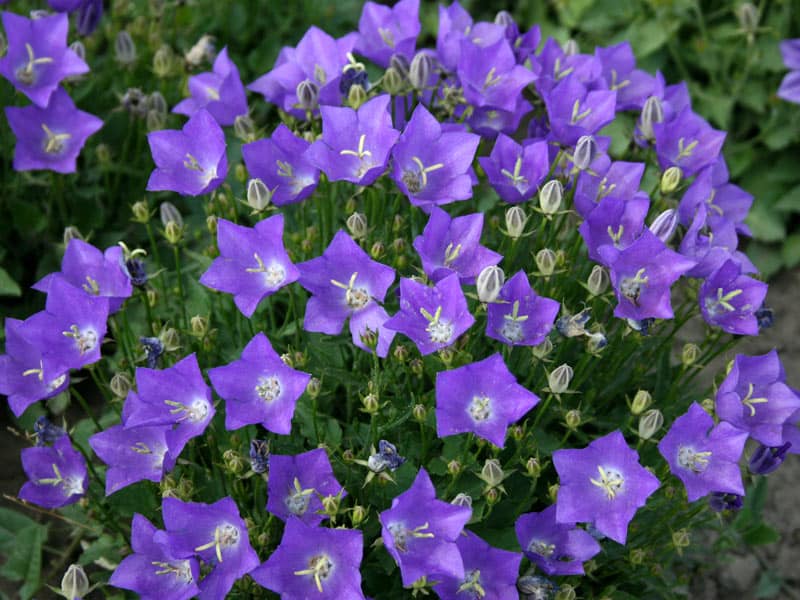

Perennial bells after flowering
Garden bells, after they have faded, need care before the onset of frost. How bells grow was discussed above. The following is a little about how to protect the plant in winter.
How to collect seeds
In order to collect seeds, you do not need to wait until the capsules open. If you notice that they have become brown in color, the inflorescences on which there are seeds are cut and left in a place where there is no moisture and where there is good ventilation. They should be there until they ripen.
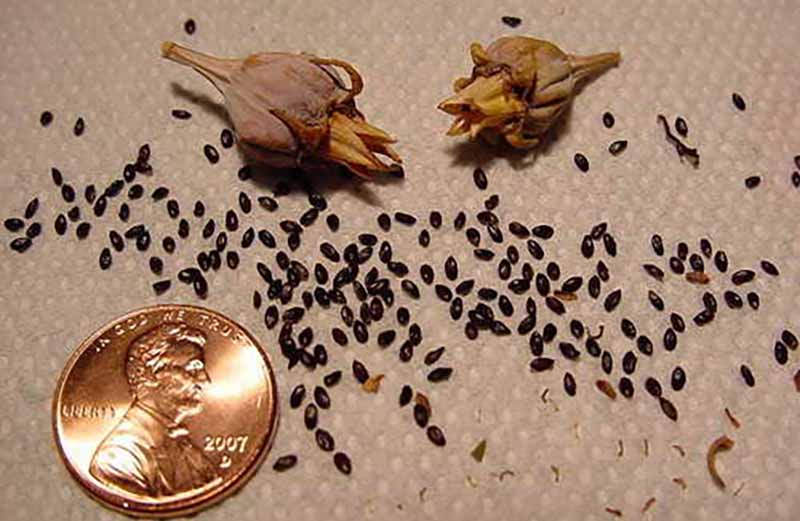

Bell seed
Preparing for winter
When September ends and October begins, the stems need to be cut to the very root. Most species are able to endure winter without shelter, but those that love warmth, southern species, should definitely be covered with products of natural origin. For this, foliage, needles, branches are suitable. Species that are ranked among the representatives of tall growth need to be covered by 15-20 centimeters with humus or dry peat.
Types and varieties of bells with photos and names
- The bell is medium - a meter-long plant. In appearance, it looks like an inverted glass, which is dressed in a skirt. One stem can contain up to 50 flowers.
- Terry bell is a pyramidal inflorescence. Flowers up to 6-8 centimeters wide.
- A cup and saucer bell and bell Chinese service - look like a set of cups and saucers, only inverted.
- The pyramidal bell is considered one of the most beautiful tall representatives. Height - 1.5 meters. The blue and white petals make up the flowers, which in turn create a kind of spike.
- Bell chio blanco - 0.35 m height. The compact bush consists of white handsome men.
- Bell crimson ringing - flowers of a terry structure. 0.75 meters height.
- Bell constellation - inflorescences in the shape of a ball are collected from bells of pearl white and pale blue shades. Easily tolerates winter. Maybe for this reason it is so widely used in garden decoration.
- Bell pyramidal mix - has a high growth of -1.7 meters. The inflorescence itself reaches 0.7-0.9 meters long.
- Bell a droplet - a smooth or terry flower with its shape resembles a glass. Soft blue, pink, white flowers make up the inflorescences of a loose structure.
- The bell is daisy-leaved - 10-15 centimeter stems are weak, and the blue fruits themselves are massive in size.
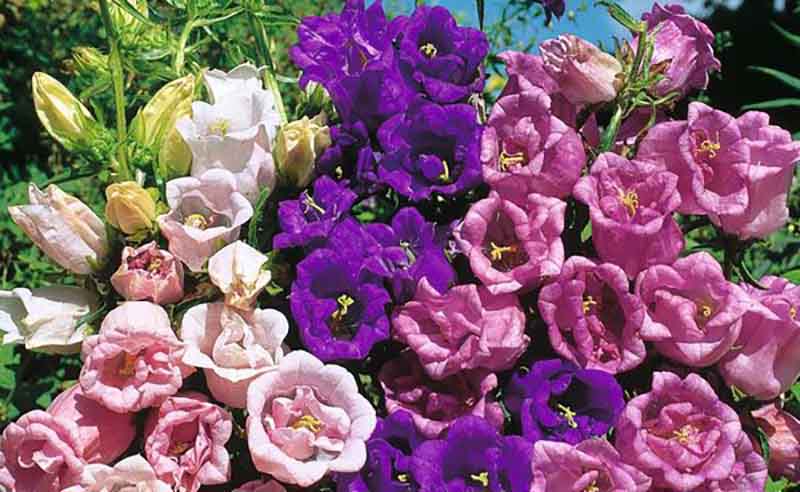

Bell crimson ringing
Biennial bells
- The bearded bell is the birthplace of the subalpine belt of the Mediterranean. Sometimes it grows only up to 4 centimeters, maximum - up to 30. The top of each flower is omitted. Its shape is reminiscent of both a bell and a glass.
- Hoffman's Bell - a 0.5 meter bush has many branches. Creamy or completely white fruits also seem to droop to the ground.
- The bell is tirsoid - funnel-shaped flowers make up an inflorescence that looks like an ear.
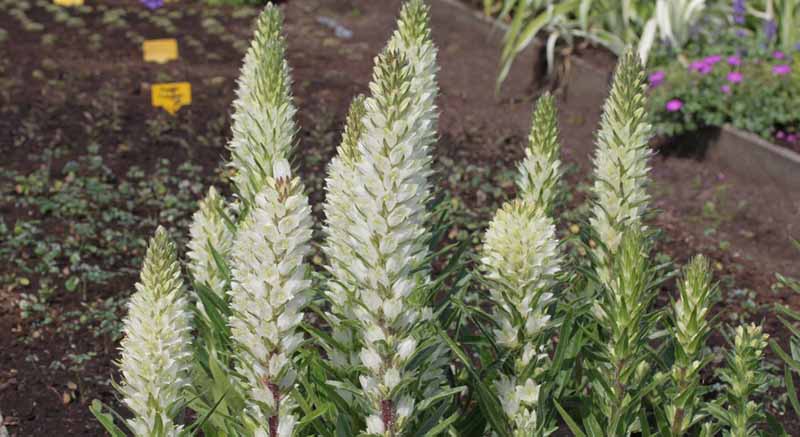

Thyrsoid bell
Low-growing species of perennial bells
- Carpathian bell - shrub grows up to 30 centimeters. Purple, blue or white egg-shaped leaves are of two types: long-stemmed and stemmed. The following types are known:
- Celestine and Isabelle - painted sky blue
- Carpatenkrone - purple flowers.
- Clip - no higher than 0.2 meters in height. The flowers are 5 centimeters wide. They are planted on the street and at home.
- Gargan - 15 centimeters high. Fragile shoots seem to creep and rise. Round leaves have three teeth. Flowers, like stars, only blue.
- Major - pastel blue flowers
- H. Paine - blend lavender flowers.
- Shamiso - 3-centimeter independent flowers are colored blue with a purple tint.
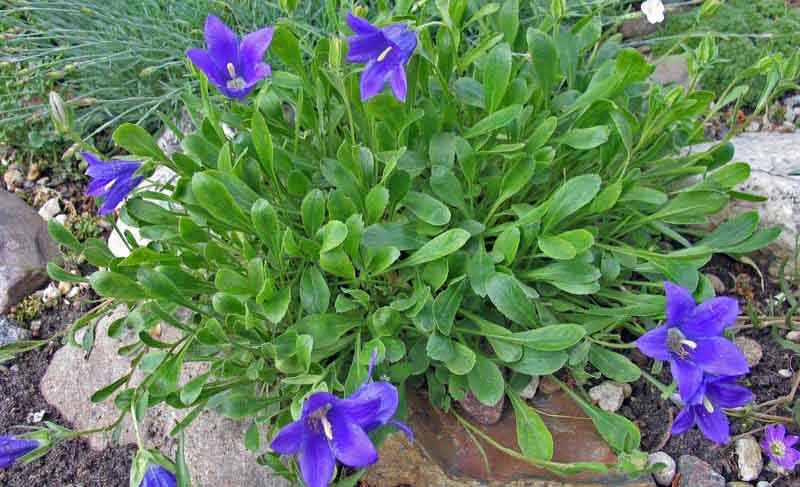

Bell Shamiso
Perennial bells of medium height
- Komarova - 45 cm stems have many large flowers with sharp lobes that are turned away.
- Spot - 0.5 meter stems are thin in structure. The flowers resemble bells and goblets. The corolla is speckled with purple.
- Alba nana is a 20 cm shrub with white petals.
- Rubra - the petals are painted in rich colors.
- Sarastro - purple flowers are located on a 60-centimeter shrub.
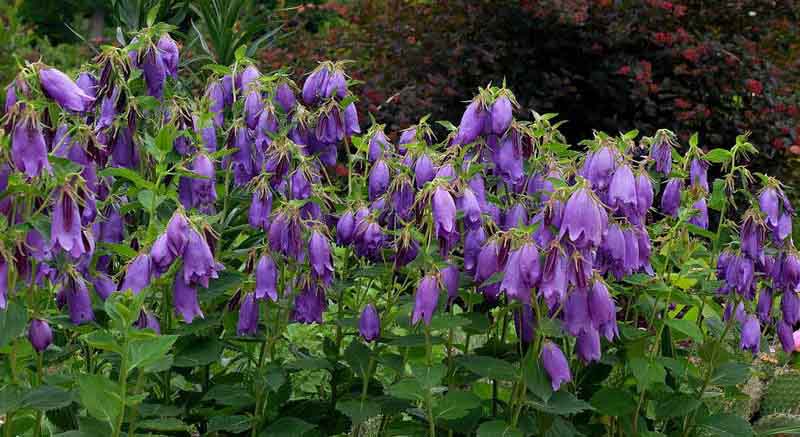

Bell Sarastro
Tall types of bells
- Broad-leaved - meter-long stalk naked. Leaves are 12 centimeters long. The flower grows up to 6 centimeters. From early summer to late summer, the plant produces white, blue funnel-shaped flowers.
- Brantwood - purple petals.
- Alba - white petals
- Makranta - large petals are painted in dark purple colors.
- Peach - 0.5 - 1 meter shoots stand upright. The leaves have a jagged edge, similar to peach leaves. There are varieties of crown, there is a double type. Several flowers make up an inflorescence.
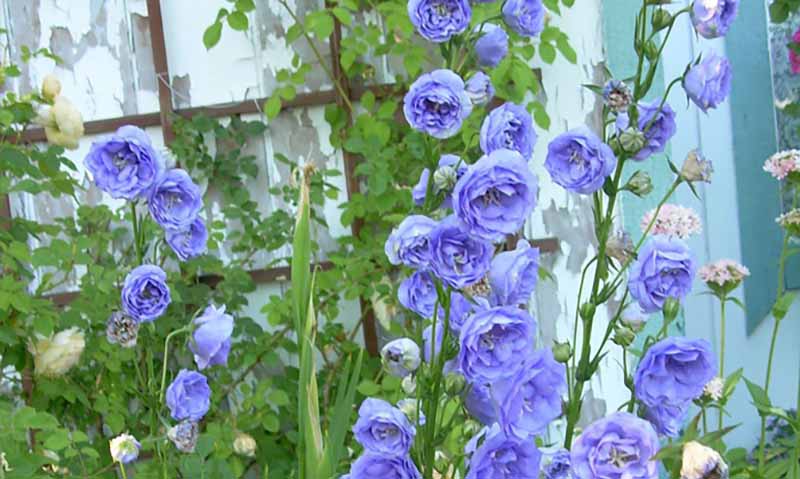

Bell peach La Belle
- Tetam Beauty - large size flowers of pastel blue shades.
- Snowdrift - flowers of white paints.
- New Giant Highbrides Blend - Maximum can grow up to 0.75 meters. Large petals are either pure white or blue in a variety of shades.
- Milk-flowered - 0.5-1.5 meter bush. It lives quite easily in heavy loamy soil. The inflorescence resembles the shape of a brush.
- Alba - white petals
- Cerulea - inflorescences of blue tones
- Pritchard Verayeti - 1.5 meter high shrub with blue flowers with lavender notes.
Reproduction methods
The Campanula bell can be propagated in different ways.
Propagation by cuttings
To propagate a flower by cuttings, the process begins at the beginning of summer. First, a shoot is cut from the lower part of the shoot of a healthy adult bush, for this a sharp knife is used. The shoot is dipped into a container of water, leaving foliage on the surface.
After the formation of roots, the cutting is planted in a pot, previously filled with loose soil. It includes:
- sand mixture;
- peat.
You do not need to water the sprout, spraying is enough. It is advisable to place the container in a shaded place.
After strengthening the shoot, which takes an average of one month, it is transplanted into open ground.
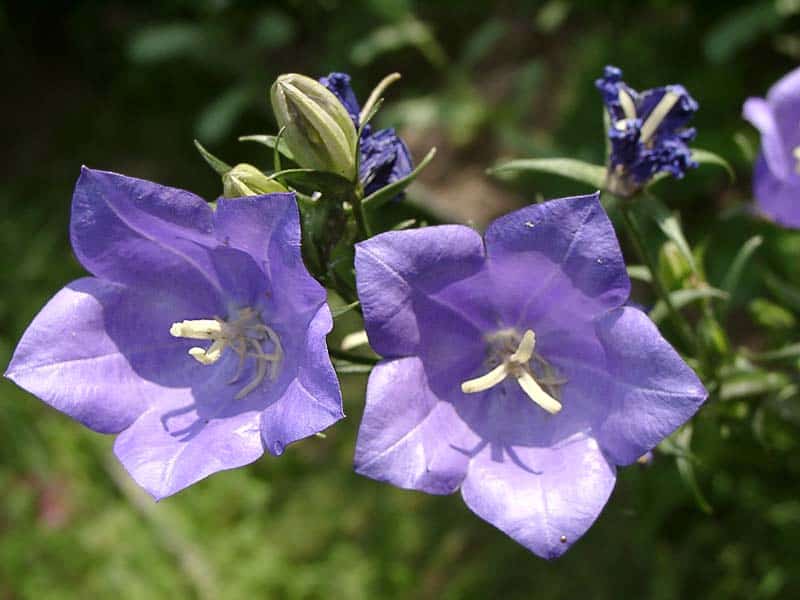

Reproduction by dividing the bush
For this growing method, you need to use an adult mother bush. It is carefully dug out in late summer or early autumn, then divided into 2-3 parts.
Each of them must have at least an aerial part and rhizomes, as well as at least one growth bud. Delenki are seated in permanent places so that they take root before the onset of frost.
Gargan bell (Campanula garganica, syn. C. elatines var. Garganica)
Creeping rhizome perennial from Southern Europe.
Gargan bell
Its parameters: height 5 cm, width up to 30 cm. Leaves up to 3.5 cm long from reniform to oval-heart-shaped. The flowers are star-shaped, bright blue, up to 2 cm in diameter, in brushes. Blooms profusely in summer.
Decorative varieties:
- ‘Dickson’s Gold’, f. aurea - yellow leaves, blue flowers;
Bell gargan 'Dickson's Gold', exterior. Its flowers are close-up. Photo from the site edrom-nurseries.co.uk
- 'W.H. Paine ‘- lavender-blue flowers with a white center.
All of them form low cushion-like sods.
Landing
For planting in open ground or transplanting a plant, you need to prepare a place in a well-lit area with diffused light. You can also use areas with partial shade.
The absence of drafts is important. It is undesirable to plant a plant in lowlands, other places where moisture stagnation occurs.
The land on the site must be neutral or alkaline. If the soil is clay, peat and sand are added to it, wood ash and humus must be added to the sandy soil. It is necessary that the soil is loose, which will provide air flow to the root system.
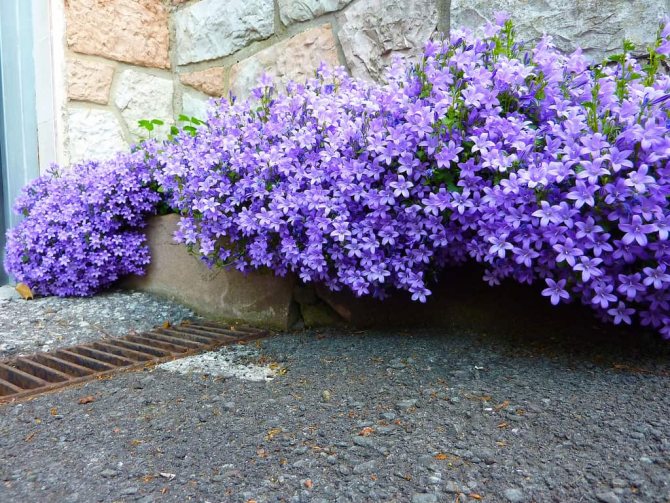

Before planting in the fall, the soil should be:
- dig up;
- get rid of weeds that are dug up by the roots.
After loosening, top dressing is carried out using organic mixtures.
First, at a distance of 30 cm from each other, holes are dug about 10 cm deep. They are thoroughly moistened, then the plants are planted. They are carried along with the old clod of earth.
In order not to harm the roots, the flower is not shaken, the soil is not knocked down. A bell is placed in the center of the hole. Free space is covered with earth, carefully tamped, watered abundantly.
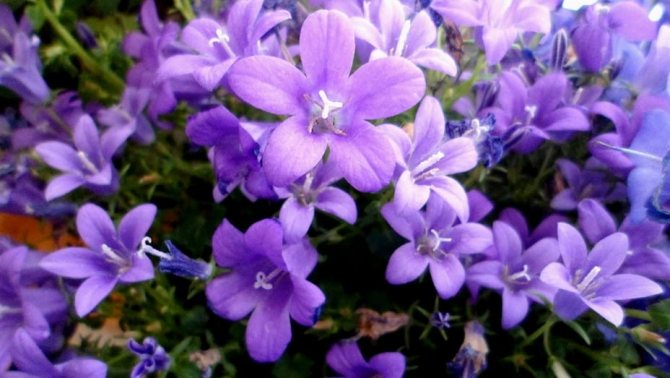

Growing conditions
We will find out in what place in the garden planting and caring for the Carpathian bell will be most effective.
Seat selection
The plant is unpretentious to its habitat, so you can plant a bell both in the sun and in partial shade. Shady places, however, are not very desirable for the plant, since they will not allow the bell to demonstrate all the beauty of flowering. In a shady place, the color of its petals will not be so bright.
The ideal place to grow these plants is a rocky hill - natural or artificial. On a hill, the roots of flowers will not freeze due to stagnant water in winter.
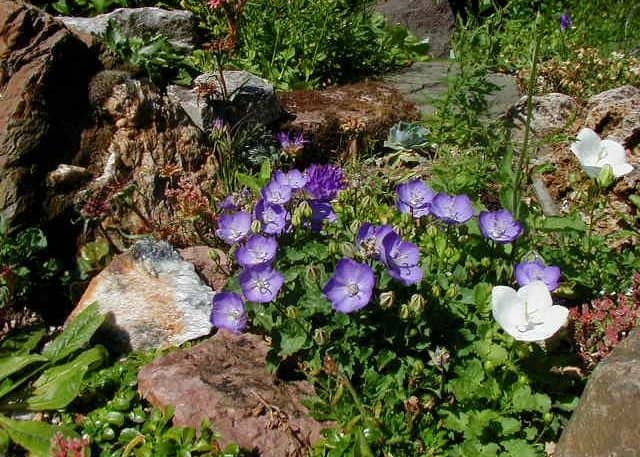

Soil composition
The bell will grow well in fertile soil, well-drained, permeable, with a neutral or slightly acidic reaction.
You should not plant the flower in soil with poorly permeable, heavy, dense soil. In such soil, stagnation often occurs, due to which the bell often dies. The fact is that the roots of the plant cannot tolerate prolonged waterlogging, they rot.
However, if the soil on the site is exactly this - dense and heavy, before planting a flower, you can improve it, make it looser. To do this, you need to dig up the bed, adding river sand and peat to it.
If the soil, on the other hand, is too loose and loose, it should be mixed with humus or sod soil. This measure is necessary, since the roots of the plant can freeze in winter in excessively loose soil.
Important: before planting seedlings or seeds in the ground, the latter must be properly moistened.
Care features
After planting the plant, the main thing is to provide it with shading if the sun is shining brightly. If this is not done, excess lighting will result in the foliage either turning yellow or brightening greatly.
The rest of the plant is unpretentious in care, it needs the usual conditions for good growth and development.
Watering
The plant loves a lot of moisture, especially during the period of active growth and flowering. Watering is carried out every day with small volumes of water at room temperature. In this case, you need to ensure that there is no stagnation of water, this leads to rotting of the root system.
If drought reigns in the yard, the frequency of soil moistening is doubled. In this case, the flower is watered in the morning and evening hours.
If the soil is allowed to dry out:
- foliage will become smaller;
- flowering will begin later.
To retain moisture and reduce the frequency of watering, the soil around the plant is mulched with peat, fallen pine leaves or straw. In the fall, watering is reduced.
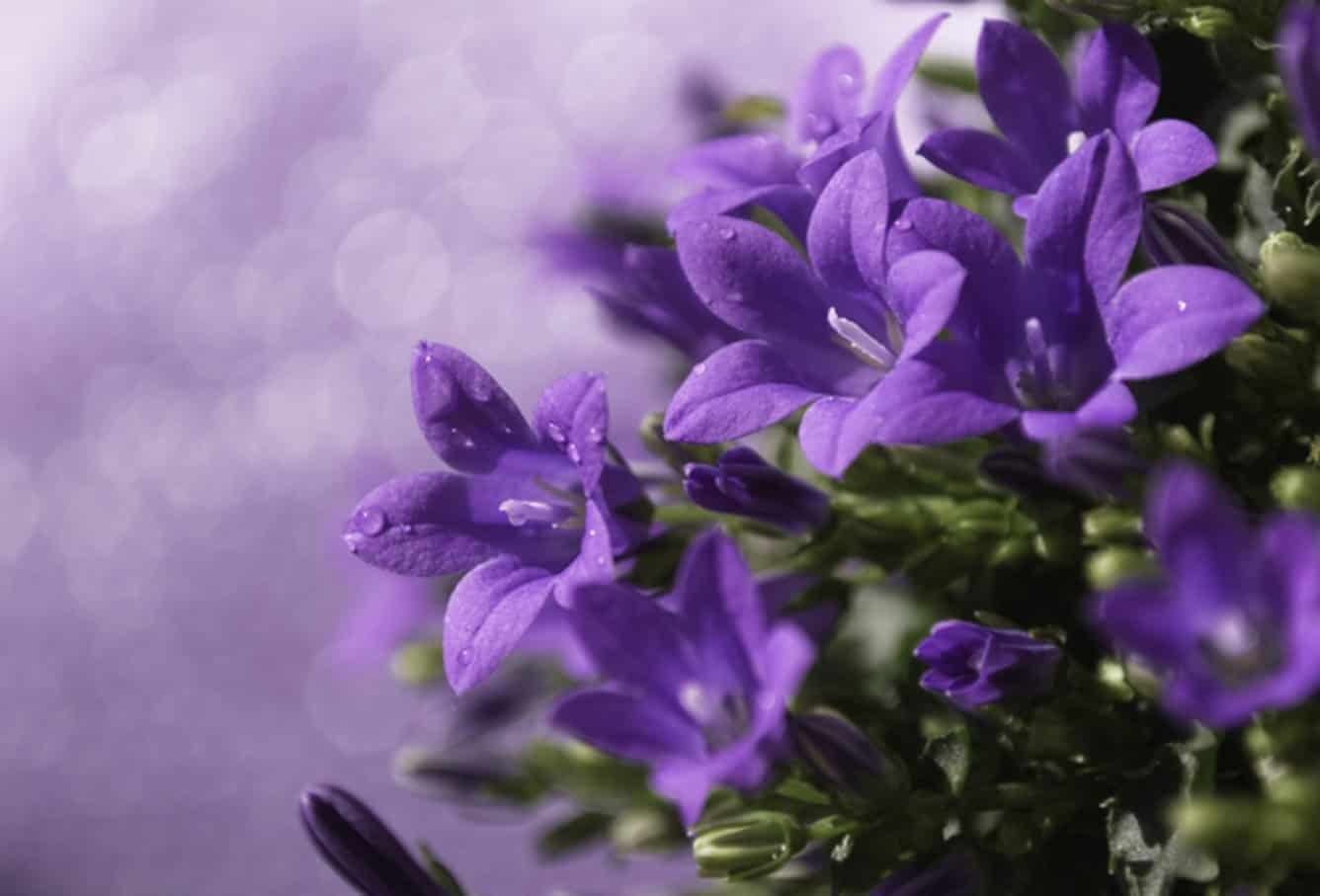

Loosening and weeding
Weeding should be done regularly to get rid of weeds on time. They can harm the plant by slowing down the rate of growth and development.
Loosening is performed after each watering. This allows oxygen to flow to the roots, which guarantees abundant flowering.
Top dressing
The flower needs replenishment, which is provided by fertilizers. They are applied before germination, as well as during and after the completion of the flowering stage.
Top dressing is carried out every 2 weeks, while:
- in the spring, use a mixture with nitrogen in the composition. Their help accelerates the growth of foliage.
- during the budding period, the mineral composition is used once;
- at the beginning of flowering, potash or phosphate mixtures are added.
Fresh manure cannot be used, it has a bad effect on the state of the root system, provoking its rotting.
Garter
If the plants stretch too far, they need to be tied up. Without this, they can bend over and break off from strong gusts of wind.
Pruning and wintering
Every year in October, pruning is performed, during which shoots are removed and mulching is carried out with peat, fallen leaves for the winter. It is important to remove the shelter in time when spring comes, otherwise the flower may vanish.
Also, during the flowering period, it is necessary to remove dried buds in time to ensure the appearance of new flowers, to ensure abundant flowering. Some varieties may then begin to bloom again.
Growing seedlings
Usually the Carpathian bell is grown in seedlings. Next, we will consider all the nuances of this process.
Stratification
To harden the planting material, they begin to prepare it already in February. Starting from this month until March, the seeds should be kept at a temperature of +20 degrees, not forgetting to moisten them regularly. The procedure will make the seed more resistant and viable.
If during the stratification process some of the seeds have sprouted, they should be transplanted into the ground. After a month of hardening at a temperature of +20 degrees, the next month and a half, the seeds must be kept at a temperature of +4 to -4 degrees.
Sowing
After hardening, the bell seeds are placed in containers with soil, while the seeds do not need to be buried. Germination takes place at a temperature of + 10-15 degrees.
Seeds do not require standard watering; instead, they must be periodically sprayed from a spray bottle. This gentle moisturizing will avoid seed erosion.
Seedling care
Carpathian bell seeds germinate 10-25 days after sowing in the ground. Since the seeds are small, the seedlings are usually quite thick: they need thinning.
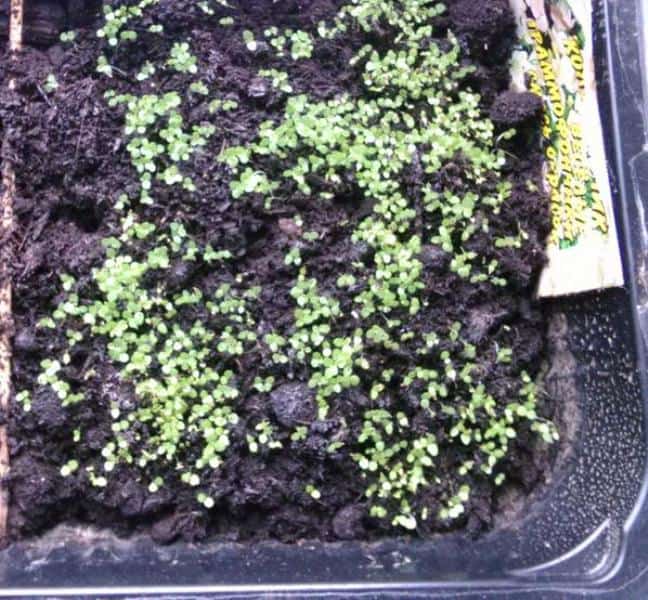

A pick is made as soon as the first pair of true leaves appear on the sprouts. In addition, it is necessary to regularly moisten the soil in containers, as well as ventilate the seedlings. Two weeks after the pick, top dressing is applied for the first time.
At the age of one month, the seedlings of the Carpathian bell are ready to move under the open sky.By this time, the root system of the plant was already sufficiently developed, and the seedlings themselves had time to get stronger.
Attention: if you live in the southern region, you can plant seeds directly on the garden bed, without first germinating the seedlings.
Diseases and pests
Campanula is disease resistant. Diseases develop mainly against the background of poor quality care. This could be:
- powdery mildew;
- nematodes;
- rust;
- fungal diseases.
These problems arise due to stagnant moisture, lack of light. To eliminate the disease, the soil and the plant are treated with means with a foundation or copper. You can also decontaminate the earth with a potassium permanganate solution.
Among the pests. who can choose a flower, there are aphids, ants and slugs. You can rid the culture of them with the help of insecticides.
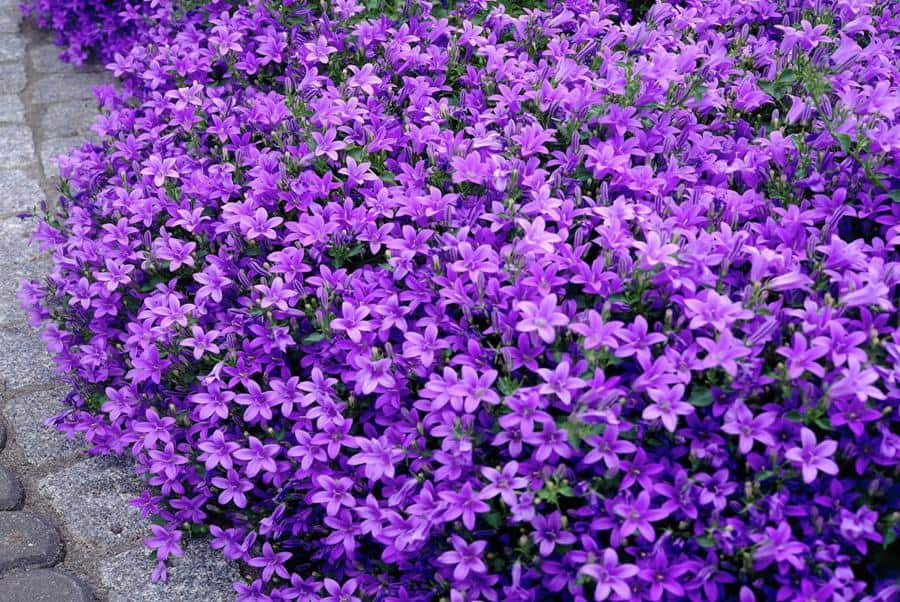

Small-leaved bell (Campanula cochleariifolia, syn. C. bellardii, C. pusilla)
It is a loose soddy perennial from mountainous Europe.
Spoon bell
Its parameters: height 8 cm, width 30 cm. The leaves are petiolate, ovate-rounded, 2 cm long. The flowers are bell-shaped, drooping, from white to lavender, blue, 1.5 cm long. It blooms in summer, very profusely.
Decorative varieties and shapes:
- ‘Elizabeth Oliver’ - double flowers, light lavender blue;
'Elizabeth Oliver'
- ‘Miranda’ - gray-blue flowers;
- ‘White Baby’ - white flowers.
'Miranda' spoon bell. 'White Baby' spoon bell. Photo from the site
The turf of these bells is not dense.
Brief conclusions
- Garden campanula is a flower that has about 300 varieties. Such a variety of species will allow you to easily choose a plant just for your flower arrangement.
- To grow a crop, you need to choose the right piece of land. She needs sunlight, but diffused. Partial shade is allowed, the main thing is not strong shading, otherwise the foliage will suffer.
- The Campanula bell requires a lot of water. It is watered once a day, and during a drought, the moisture rate is doubled. The water should be at room temperature.
- It is important to regularly loosen, ensuring oxygen flow to the root system. This ensures a lush bloom.
- In some varieties, in order to achieve re-budding, dried flowers should be removed in time.
- The culture needs shelter for the winter. You can protect the roots with peat or fallen leaves.
Carpathian bell (Campanula carpatica)
The most common in culture in Russia is a low bell. He comes from Central Europe (Carpathians).
Carpathian bell
Its parameters: height up to 30 cm, width 30-60 cm.The leaves in the root rosette are long-petiolate, ovate-rounded, up to 5 cm long.The flowers are large, bell-shaped, blue, violet-purple, white, 3-5 cm in diameter. abundant in summer.
Decorative varieties and shapes:
- ‘Bressingham White’ - large, white flowers;
Carpathian bell 'Bressingham White'
- ‘Jewel’ - compact, 10-15 cm high, purple-blue flowers;
Bell Carpathian Jewel. Photo from the site chto-
- ‘Turbinata’ - dwarf (10-15 cm high), lavender-blue flowers;
Carpathian bell 'Turbinata'. Photo from the site
- ‘Weisse Clips’ (syn. ‘White Clips’) - 20 cm high, white flowers.
Carpathian bell 'White Clips'. Photo from the site 7.
Forms dense cushion turf.
Use in the garden
The flower has a bright color, so it will become an adornment of any flower bed, mixborder.
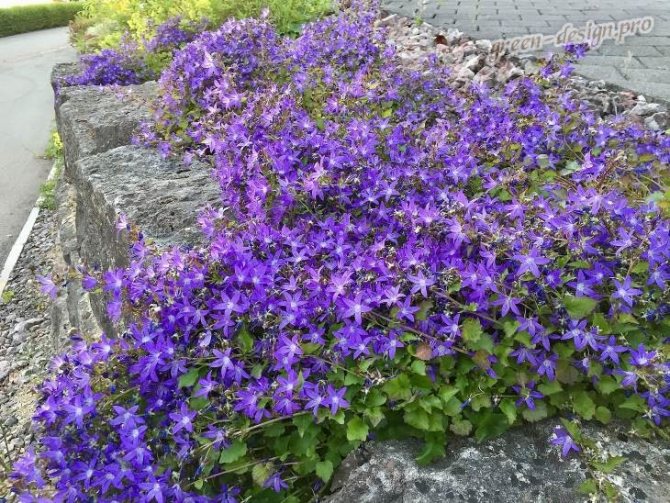

Campanula fits perfectly into different rock gardens and rockeries.
Often used in group landings. For the combination, flowers similar to a bell are used: phlox, irises, peonies, cineraria. The culture looks beautiful against the background of dwarf coniferous plantations.
How to grow bells in the garden. General rules for planting and care.
The landing site should be either sunny or light partial shade. Any soil will do, well-drained.
Drained soil - soil brought to normal water balance. It is achieved most often by constructing an active or passive drainage of excess moisture. Active retraction is used, for example, on modern football pitches. Passive - sandy or stony layer in the soil.
Do not plant garden bells:
- to areas where water stagnates;
- in lowlands with loamy or clayey soil;
- places that are flooded with water.
Bells can be grown anywhere else and they will feel great. In the event that the groundwater is located close to the surface, you can make a high, raised flower garden and make good drainage.
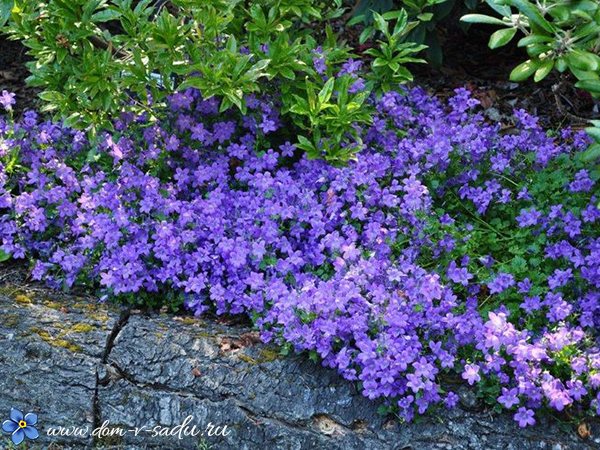

Pozharsky's bell (Campanula poscharskyana)
A wonderful creeping perennial from mountainous Croatia, Bosnia and Herzegovina.
Pozharsky's bell
Its parameters: height 15 cm, width up to 60 cm. The leaves are long-petiolate, heart-ovate, up to 2.5 cm long. The flowers are large, up to 2.5 cm in diameter, star-shaped, light lavender, with a white center. Blooms throughout the summer, until the autumn cold.
Decorative variety:
- ‘Stella’ - bright purple flowers.
Bell Pozharsky 'Stella'.
The bloom is so abundant that you literally can't see the leaves! Like light lavender, purple floral waves splash on the parapets, cover the borders.
Bell types
Campanula varieties are one- and perennial. Perennials are prone to degeneration. In this regard, the flower is often grown in the form of an annual. More than 300 species are known, more than 150 of which are found in Russia and the CIS countries.
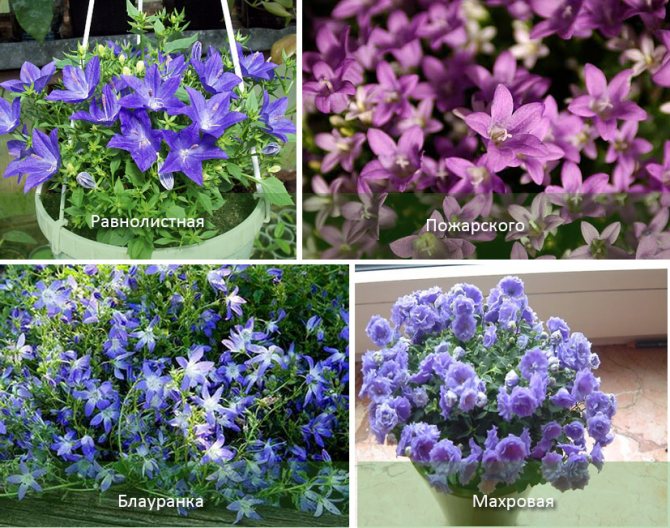

Home views
There are 15 plant species in the European part of the Russian Federation. Garden perennial campanula: nettle-leaved, broad-leaved, lactic-flowered and others. The most famous domestic varieties are Terry Campanula, Mini Terry, Equivalent, Peach-leaved, Portneshlag, Pozharsky, Carpathian (Carpathica) and Blauranka. Some varieties of Carpathian and peach-leaved species can be grown in the garden.
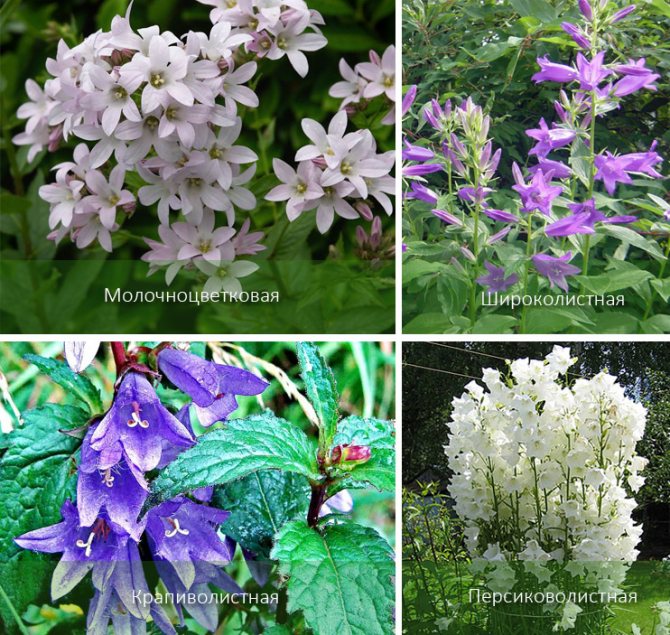

Garden views
Such species as campanula glomerata (“prefabricated bell”), chirillo, torpedo and isophylla mix are somewhat less common.
Description and characteristics of the plant
The birthplace of Campanula carpatica is the mountainous regions of the Carpathians and Central Europe. Perennial herbaceous culture belongs to the Bellflower family. The plant grows in a compact upright bush no more than 0.4 m in height. Thin stems are covered with narrow-lanceolate leaves, collected at the base in a dense basal rosette.
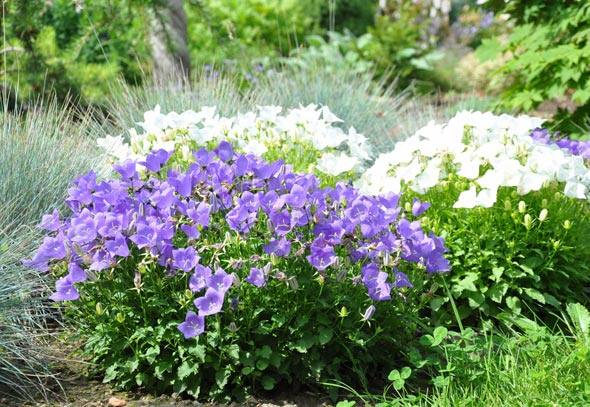

Campanula carpatica - perennial herbaceous crop
During flowering, which occurs in the second half of summer, the campanula is covered with delicate goblet buds with a diameter of about 50 mm. The natural color of the petals is blue, however, there are white, blue or purple varieties.
Watering recommendations
There is no need for strict watering of the Carpathian bell, especially when growing it on the street. But in severe droughts or extremely high air temperatures, it is recommended to pour at least 10 liters of water under one bush. To prevent rotting, the soil should be well loosened after watering. This will also provide additional air flow.
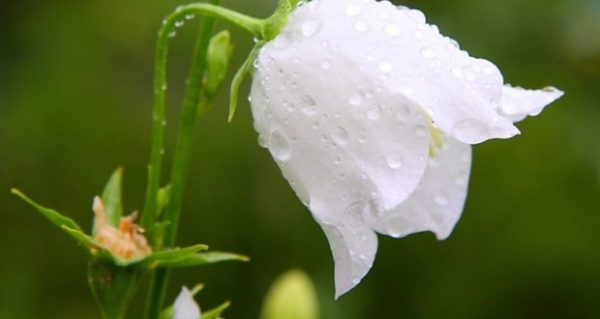

When watering, it is advisable to avoid getting water on the buds
Inflorescences and collection of seeds
After the inflorescences have completed their life cycle, they should be removed immediately. A seed capsule has already formed on them, which can lead to self-seeding. Because of this, unwanted bell bushes may appear throughout the entire area, since the seeds easily take root and are quickly carried away by the wind, insects and birds. In addition, the removal of inflorescences makes it possible for new ones to germinate.
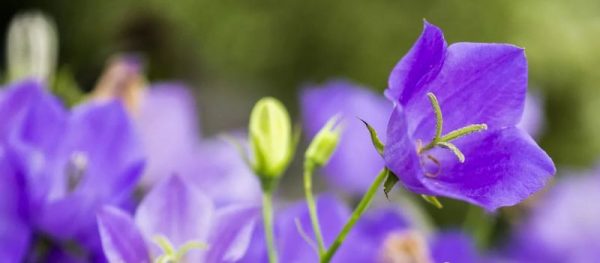

The size of one flower is no more than 5 cm
If you want to collect the seeds of the Carpathian bell, you should collect the formed seed.To do this, leave a few inflorescences and wait until they form a fruit capsule. As soon as it becomes dark, there will be signs of their disclosure, you should immediately cut off the boxes and dry them well. Store the seed in a dry, well-ventilated area.
Attention! If the plant is planted from seed, the flowering of the Carpathian bell is usually observed in the third year.
Bellflower (Campanula raddeana)
A beautiful creeping bell from the Caucasus.
Bell Radde. Photo from phytoimages.siu.edu
Its parameters: height 20-30 cm. Leaves are long-petiolate, triangular. The flowers are light purple, drooping. Blooms profusely in June-July. It grows quickly, forming dense sod; distribution control is needed. Photophilous. It is frost-resistant: its critical winter minimum is -23 ° C.
Choose different types and varieties of bells in our catalog, which contains offers from large online stores of seeds and planting material. View a selection of bellflower seeds.
Herbaceous perennial bells belong to the large family of the same name - Bellflower. This family has more than 300 different species in its arsenal, which have very obvious and more than specific differences, as they grow in various regions of the globe. What types of perennial bells exist, we will consider below in the article and show in the photo.


Separation of bells - multi-year-olds by height
Stunted bells
These are quite common plants among summer residents of our country, among them the Carpathian one stands out. It blooms for a long time with purple or white flowers up to 5 cm in size.This culture has also long been known to flower growers, since 1770, the Carpathian bell has been blooming for two months, therefore it is widely used in landscape design and amateur floriculture. It is worth listing its most popular varieties:
- white - Celestine, Isabelle;
- blue - Chenton Joy, Riversley;
- purple - Carpatenkrone;
- and also Clip.
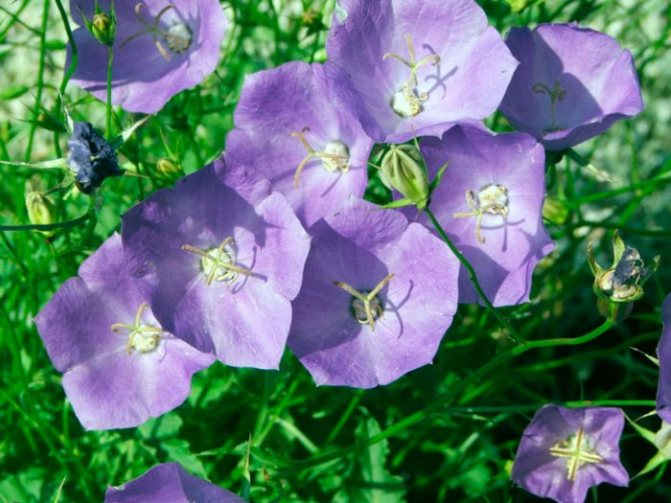

Spiral-leaved the species has several varieties, differing in color: Alba - white, Loder - blue, Miss Wilmott - blue. All of them have rather small inflorescences, and shoots, in the full sense of the word, spread over the soil surface. This is also a "veteran" he is more than 300 years old.
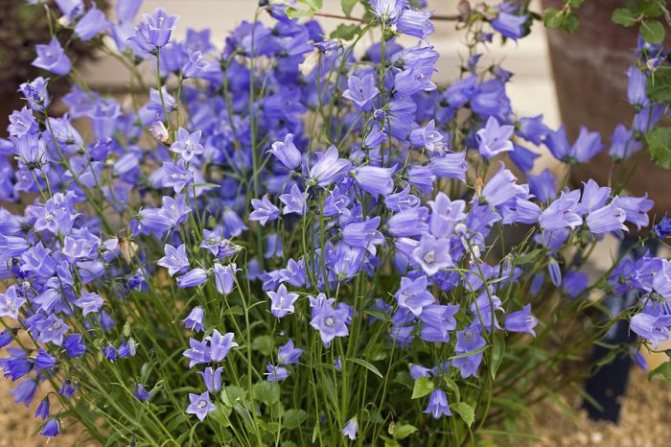

We can mention several more varieties of perennial ground cover bells: saxifrage, povoynichkovy, turfy, trident, as well as such names as Osh, Rainer, Uemura.
Medium bells
The bell is the most popular here. Takeshima, up to 60cm high, with many lateral, ascending, and creeping shoots. This species has various colors and terry varieties. Flowers bloom in mid-June and last until early August. Famous and loved varieties of gardeners:
- white - Beauty Trust;
- terry - Wedding Belz.
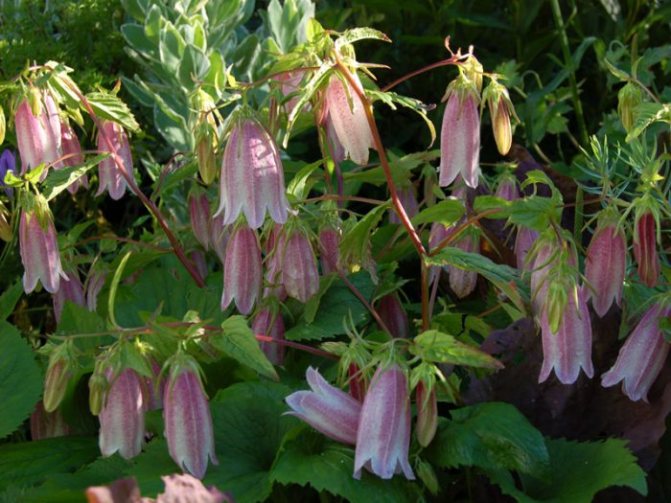

Komarov's bell - a spectacular flower, with branchy shoots up to half a meter. Corollas are rather large, have a light purple color.
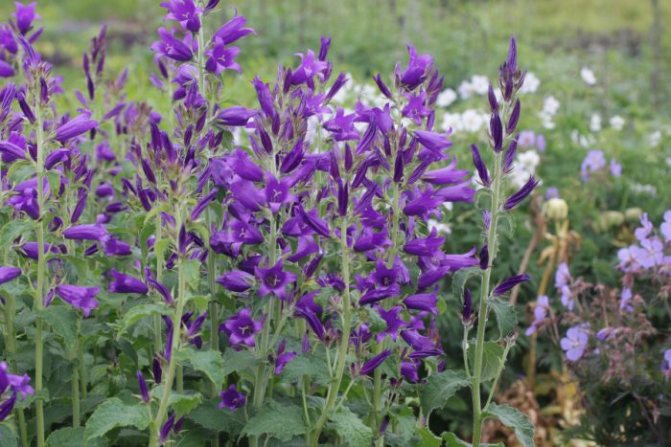

Point known as a native of the Siberian regions and the Far East, it will grow up to 55 cm. The flowers are similar to glasses with a light fluff, they are located on long pedicels of a light shade. Highlighted sotra:
There is a huge variety of medium-sized bells, unfortunately not all species are cultivated in our country, however, for general development it is necessary to name the following: carnica, Spanish, rhomboidal, ocher, hybrid Kent Bel, Pink Octupus.
Tall perennial bells
Broadleaf found in different places, from the Caucasus to Asia Minor and Siberia. Its habitats can be deciduous forests, river banks, coniferous groves. Famous varieties:
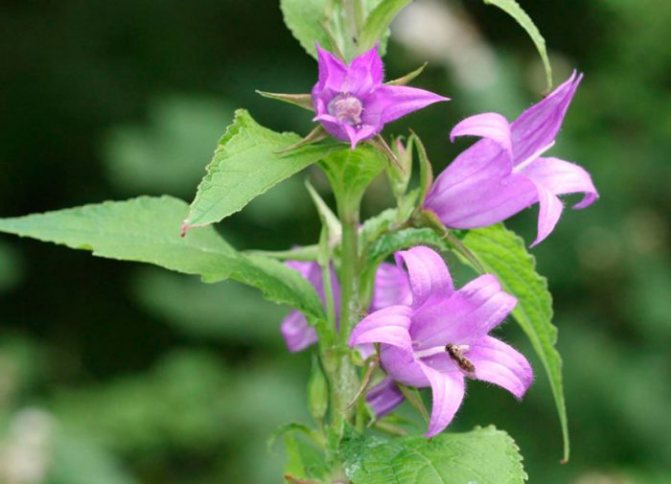

Peach one of the most common bells in Russia, Ukraine, the Caucasus, Siberia.Corollas reach five centimeters in size, collected in panicles of inflorescences, can be double and crown.
- blue - Bernice;
- terry-Exmaus;
- white_Snowrift;
- a mixture of varieties - New Giant Hydebrides.
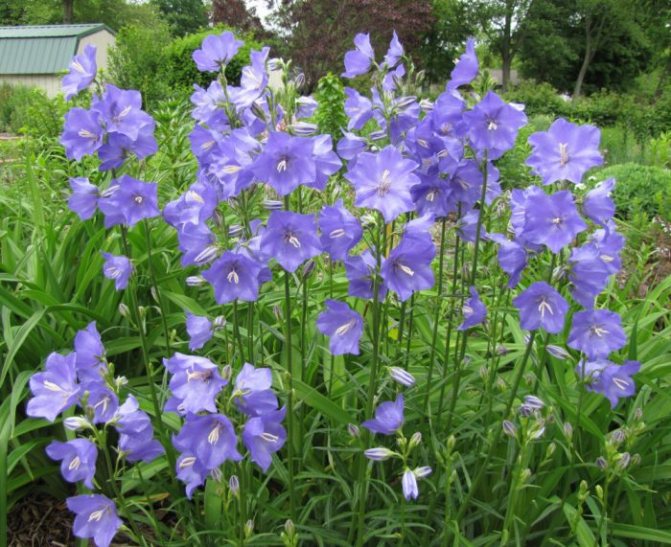

Several more well-known species: lacto-flowered, twisted, bolognese, large-flowered. All of them are decorative types.
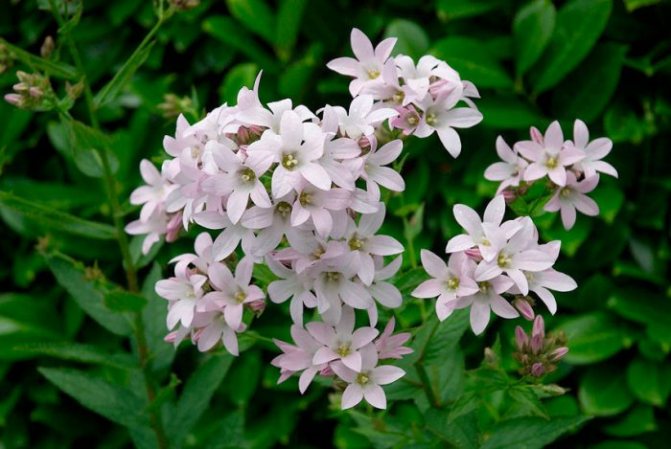

You can safely propagate perennial varieties by rhizomes, cuttings, stolons and cuttings with elements of roots. The fact is that these species are not always able to preserve their varietal characteristics by seeds; often completely different flowers are obtained from the seeds of one plant. Terry varieties can only reproduce vegetatively, since they have no seeds at all.
Flowers with tap or carpal roots belong to the category of vegetatively immobile, and such plants are grown only by seed. Varieties with short roots are vegetatively inactive, a method of division and cuttings is available here. Flowers with creeping and rather long roots are considered vegetatively mobile. All types of reproduction are used here: with the help of cuttings, layering, offshoots of roots, delenok, seeds.
Due to their natural resistance, bells are rarely exposed to both diseases and attacks of harmful insects. It is possible to cite isolated cases when "chenille" suddenly showed signs of the disease, as a rule, this happens if the bush grew in one place for a long time without transplanting.
The soil is capable of accumulating pathogenic bacteria and microorganisms that can adversely affect the growth of bells. Fusarium, sclerotinia can ruin plantings, so try to replant flowers from time to time and carry out soil treatment with Fundazol. For this, a solution is prepared from a 2% drug and water in accordance with the manufacturer's recommendations.
Of the pests, one can single out the slobbering penny that appears on plants during especially wet periods. To destroy it, such a folk remedy as garlic infusion is used. Processing is carried out several times with a period of two to three days. Low varieties can suffer from slugs, which are afraid of hot pepper decoction like fire.
Perennial bells, the planting and care of which are described in detail in our article, are not demanding on growing conditions. But in order to achieve long-term flowering, it is necessary to choose and prepare the planting site correctly, and provide the plants with everything they need.
Perennial garden bells (lat. Campanula) have a simple flower shape, not overloaded with complex combinations of petals and stamens. They are popular with gardeners for their vibrant and long lasting bloom. The bells resemble church bells, from where they got their name, they are also popularly called the flowers of faith and hope.

